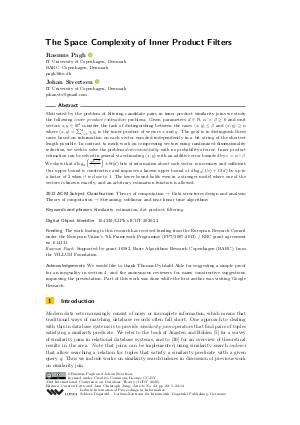@InProceedings{pagh_et_al:LIPIcs.ICDT.2020.22,
author = {Pagh, Rasmus and Sivertsen, Johan},
title = {{The Space Complexity of Inner Product Filters}},
booktitle = {23rd International Conference on Database Theory (ICDT 2020)},
pages = {22:1--22:14},
series = {Leibniz International Proceedings in Informatics (LIPIcs)},
ISBN = {978-3-95977-139-9},
ISSN = {1868-8969},
year = {2020},
volume = {155},
editor = {Lutz, Carsten and Jung, Jean Christoph},
publisher = {Schloss Dagstuhl -- Leibniz-Zentrum f{\"u}r Informatik},
address = {Dagstuhl, Germany},
URL = {https://drops.dagstuhl.de/entities/document/10.4230/LIPIcs.ICDT.2020.22},
URN = {urn:nbn:de:0030-drops-119468},
doi = {10.4230/LIPIcs.ICDT.2020.22},
annote = {Keywords: Similarity, estimation, dot product, filtering}
}

 Creative Commons Attribution 3.0 Unported license
Creative Commons Attribution 3.0 Unported license





























